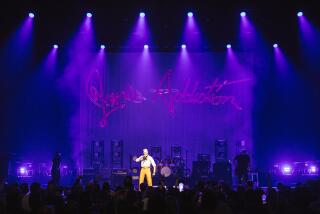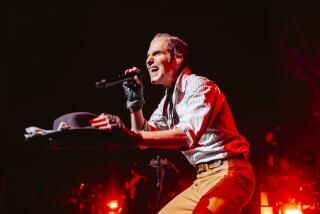Pop Singer Hits Right Notes With Head Trauma Center
- Share via
The thick, shiny chain around Jan Berry’s neck is gold, just the sort of adornment one might expect for a surf-music pioneer who is riding a wave of revived concert popularity. The tinny-looking bracelet on his left wrist, however, is something different--a Medic Alert band that lists the medicine Berry should be given if he suffers a seizure.
The creative force in the early 1960s hit-making duo Jan and Dean, Berry suffered serious brain injuries one morning in 1966 when he lost control of his speeding Corvette and slammed into the back of a parked truck. The accident happened just off Sunset Boulevard in Beverly Hills, about a mile from the spot the pair sang about in one of their biggest hits, “Deadman’s Curve.”
Learning How to Walk Again
The road back has been a long one for Berry, now 45. In the first years of recovery he had to relearn speaking and walking. His conversation remains halting at times, he limps and his right arm and hand are partially paralyzed. He has no vision out of the left side of each eye. Before Jan could return to performing, he spent hours relearning words to songs he had written.
“At concerts I hit the lines pretty good,” he said in an interview at the Jan Berry Center for the Brain Injured, which is expected to open in January. “I miss a line now and then, but it’s OK.”
The center in Downey is an outgrowth of Berry’s many trips to doctors and therapists at nearby Rancho Los Amigos Hospital. While there, he began visiting other head-injury victims and did two benefit performances for projects run by Disabilities Unlimited Inc., a private company that administers government-funded rehabilitation programs. When company officials landed state and federal grants to open a vocational center, they asked Berry to play a part.
“Most brain-injured people are like Jan,” said Brian Sullivan, coordinator of the Jan Berry Center. “Before their injuries they were living productive lives, working or going to school. What we want is to find something that interests them, then find something they can do in that field. Someone who was working on a 3.5 average at UCLA before he was injured isn’t going to be too excited about playing with blocks.”
Sullivan, 24, said six to eight students will use computers, video equipment and dance therapy to treat such complications of brain injury as aphasia, a loss in ability to use words. The center, across the street from Rancho Los Amigos Hospital, is assured of $225,000 annually for two years, officials said, with most of the money coming from the federal Department of Education. Students will attend free of charge.
According to Sullivan and other members of the center’s staff, Berry’s recovery was slowed by the absence of good rehabilitation techniques. They, along with Berry’s family and his singing partner, Dean Torrence, agree that a strong desire to perform again is what helped him most.
“I was a baby,” Berry said of the first years after the accident. As he spoke, his eyebrows remained lifted in the manner of someone straining to find the right word. “But I’ve always loved rock ‘n’ roll. So I was practicing with the lyrics.”
He also was staying in touch with Torrence.
“Jan called every week, wanting to perform again,” said Torrence, 46. “I encouraged him, but in the back of my mind I’d say, ‘It’s never going to happen.’ He was in too bad a shape.”
Torrence readily concedes that Berry was the driving force behind the duo’s success, which began with “Baby Talk” in 1959 and included the other Top-10 hits “Surf City” and “Honolulu Lulu” in 1963 and “Deadman’s Curve” and “Little Old Lady From Pasadena” in 1964.
“Sometimes Jan did 80% of it and sometimes 60,” Torrence said of the writing and arranging of their music, “but he never did less than 60%. He was a real technician and he was definitely the ambitious one of the bunch.”
After Berry’s injury, Torrence, a USC advertising design graduate, started a graphics business that he ran from the middle 1960s to the late 1970s. He explained why, by 1978, he was ready to try a pop music comeback.
“I was making a fairly good living, but 30% of my billing just disappeared,” he said. “People didn’t pay. Also, most of my stuff was music related, and in the ‘70s record companies were going through tight budgets. There wasn’t enough money to do work the way I wanted to do it.”
By now the ever-impatient Berry had stopped waiting and gone on the road with other partners, billing the act as Jan and Dean. Torrence, meanwhile, worked as a consultant on the 1978 television movie “Deadman’s Curve” and performed a few times with a San Jose surf revival band.
“I felt the first little ripple of what’s going on now,” he said, referring to the oldies craze. “I didn’t want to play for just the over-30 crowd, but I found out that teen-agers were coming out for the music. In 1978 Jan and I toured with the Beach Boys to test the waters. It went OK, and in ’79 we became Jan and Dean again. That went along fine until he got on drugs.”
Fake Drug Bust
Berry talks openly about his cocaine habit, which led to the pair’s breakup in 1981. At one point, while on tour in Las Vegas, Torrence staged a fake drug bust, arranging for men impersonating police officers to handcuff Berry. The ruse did not end Berry’s drug usage. What helped, however, was Torrence’s decision to tour with Beach Boy Mike Love until Berry cleaned up. After 18 months apart, the two reunited and have been working steadily since. Dates this year included Expo ’86 in Vancouver and the Alaska State Fair. They leave for a China tour Sunday.
Like many brain-injured persons, Berry has had to overcome regret. He said he still “feels guilty” for the accident, which took place right after his unsuccessful appeal of a draft notice at a Selective Service office. Berry admits he was driving too fast. Although he was alone in the car and no one else was hurt, a story that three persons were killed found its way into “Rock On, the Illustrated Encyclopedia of Rock ‘n’ Roll” and continues to be repeated.
Berry also has found his ambitions frequently stymied. After several failed attempts to be on his own, he lives with his parents in their Bel-Air home.
“He would move into an apartment with someone, and the visitors would walk off with his records and other belongings,” said Berry’s father, 76-year-old William Berry. Jan Berry shrugged in agreement and held up his hands as if to say, “There was nothing I could do.”
The singer has had to give up his dream that one day the partial paralysis on his right side will lift.
“Nowadays it’s just forget the body and go on,” Jan said, “but 10 years ago it was, ‘Oh God, how can I make it better?’ I’d get in bed and put two pillows over my head.’ ”
The senior Berry is Jan’s legal guardian and watches over his welfare. On tour, Torrence serves as unofficial guardian. The two men have different life styles and some ill feeling exists between them.
“From the time of the accident until 1981, when it got lucrative, Torrence was very scarce,” William Berry said bitterly.
“In a way that’s true,” Torrence responded. “I encouraged Jan, but we didn’t see each other very much. I’m not kidding, I worked six days a week for 12 years. So Jan was pretty much on his own. I couldn’t give the kind of professional help he needed.”
Torrence believes that Berry’s parents “do too much” in the way of caring for their son.
“I force him to think. On the road we always make him carry something--not as much as the other band members, but something. You have to, or he’ll use his disability to get away with murder. If you’re playing blackjack and you’ve got 16 and the dealer shows a 10 and you ask Jan what to do, he’ll say right off, ‘You gotta figure the dealer’s got 20, so you hit.’ But ask him where he put his airplane ticket and all of a sudden it’s, ‘Gee, ah, I dunno.’ ”
Torrence said he and Berry often talk on the phone when not touring, but that they don’t spend much time together.
‘Lives of Our Own’
“Off the road we have lives of our own,” he explained. “Jan has to have other sources of his enjoyment. We’re hoping the Jan Berry Center will be part of that.”
Ask whether Torrence is too hard on him, Berry smiles and replies, “We have to fight sometimes to survive.” He said he is looking forward to taking part in the activities of his namesake center because he has enjoyed his hospital visits to people with brain injuries.
“We go down the hallway where the beds are with the sick and say, ‘How are you?’ We say, ‘It’s not that bad; you may have serious problems, but you can survive and be happy-go-lucky once in a while.’ ”
The extent of recovery for brain-injured persons varies widely. Gary Holzman, 62, of Sherman Oaks helped found the California Head Injury Rehabilitation Center Inc., a residential center, after his son was hurt in a 1979 motorcycle accident. Holzman said he hopes the Jan Berry Center succeeds in getting its students working again.
“It’s very difficult, though,” he cautioned. “They don’t turn into very good employees. They’re out there with people who aren’t handicapped, and all of a sudden they say something dumb, or they forget something important. Even if they function at a very high level, they continue to have setbacks.”
Berry has had enough setbacks to agree that they are inevitable. He relies on Torrence to cover for him in concerts when he drops a word. He can trust his memory enough to sing lead on only a few songs. But he is glad to be working again.
More to Read
The biggest entertainment stories
Get our big stories about Hollywood, film, television, music, arts, culture and more right in your inbox as soon as they publish.
You may occasionally receive promotional content from the Los Angeles Times.










